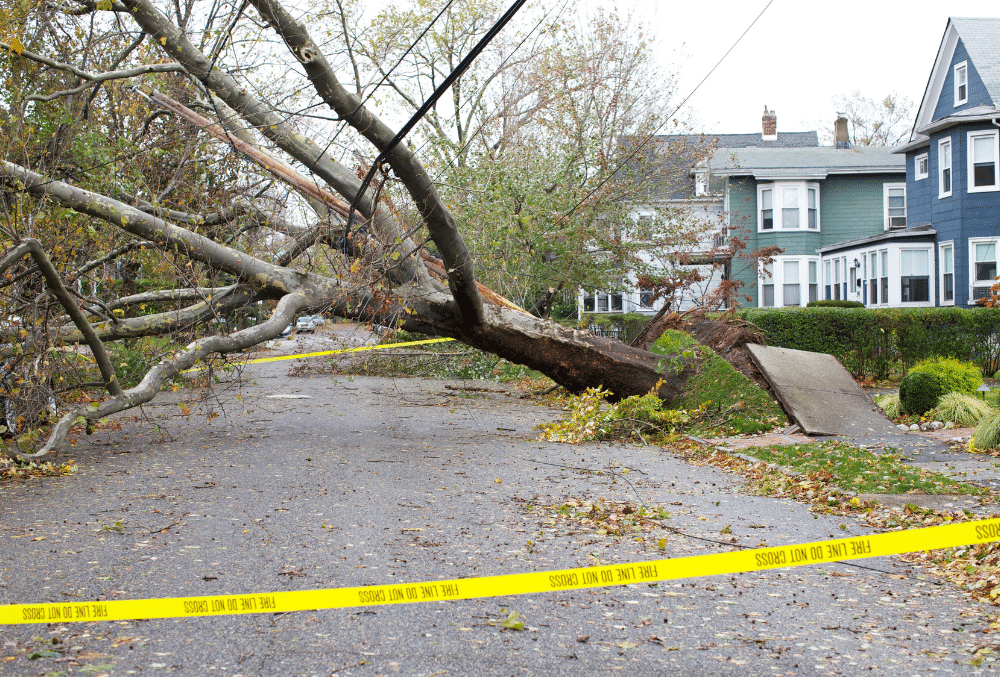Keeping Your Home Protected During a Severe Wind Storm
May 26th, 2023
The wind in Ontario can be a mighty force to reckon with, capable of causing severe damage to homes and properties. When a windstorm is on the horizon, taking necessary precautions to protect your home and ensure your safety is crucial. In this blog post, you will discover practical steps to safeguard your home during a windstorm.
In 2021, severe weather events caused over $2 billion in insured damage in Canada. We’re here to help keep your home safe and minimize the risk of windstorm damage. So, buckle up, and let us get started.
How to prepare for a potential wind storm
1. Keep trees and bushes trimmed
Trees and bushes can cause significant damage to your home during a windstorm. High winds can easily snap or uproot trees, causing them to fall on your roof or car. Trim any trees or bushes near your home to prevent them from falling onto your house. Consider removing any trees that are old, diseased, or leaning.
2. Inspect and reinforce your roof
Check your roof for signs of damage, such as loose or missing shingles, cracks, or leaks. Address any issues promptly to prevent them from becoming more severe during a windstorm.
3. Maintain your gutters and downspouts
Gutters and downspouts are critical components of your home’s drainage system. During a windstorm, they can become clogged with debris such as leaves, twigs, and branches, causing water to overflow and potentially damaging your home’s foundation.
Regularly cleaning and maintaining your gutters is one of the best ways to prevent clogs and backups. Clean them at least twice a year or more frequently if you have overhanging trees or live in an area prone to severe weather. High winds can also cause drains to detach from the house, so ensure they are adequately secured.
4. Invest in a backup power source
Consider a backup power source, such as a generator or battery backup, in case of a power outage. If you have a portable generator, ensure it is fueled up and ready to go in case of a power outage. It will allow you to keep essential appliances and devices running until power is restored.
5. Have emergency supplies on hand
Keep emergency items on hand, including bottled water, food, first aid supplies, flashlights, and extra batteries. Have enough non-perishable food and water to last at least three days for each household member.
A first aid kit is essential in case of injury. Ensure your kit includes bandages, gauze, antiseptic wipes, pain relievers, and prescription medications. Have enough cash on hand to purchase emergency supplies if necessary. If power outages are widespread, ATMs and credit card machines may not work.
6. Make a family emergency plan
Develop a family emergency plan in case of a severe windstorm or other natural disasters. Identify a safe room in your home, agree on a meeting place if you need to evacuate, and keep important documents and emergency supplies in a designated location.
Keeping Your Home Safe During a Windstorm
1. Secure loose items
High winds can turn outdoor items into dangerous projectiles that can cause significant damage to your home. Before a windstorm, take a walk around your property and secure any loose items, such as patio furniture, garden tools, toys, or any other items that could become airborne. Bring these items indoors or tie them down securely to prevent them from causing damage.
2. Reinforce windows and doors
Windows and doors are particularly vulnerable to wind damage. Consider installing impact-resistant doors and windows to reinforce your home’s structure and prevent damage. Install storm shutters to support windows, and ensure all door and window frames are secure. If you do not have storm shutters or plywood, use duct tape to help prevent windows from shattering.
3. Turn off gas and electricity
If you have not already turned off your gas and electricity, do so immediately. High winds can cause damage to power lines or cause gas leaks, leading to fires or explosions. If you cannot turn off the utilities, ensure you know where the shut-off valves are in an emergency.
4. Stay inside
Stay indoors and away from windows during a windstorm, as they can easily break or shatter during a storm. Flying debris can cause severe injury or damage, and high winds can make it challenging to stay upright. Find a safe room in your home, such as a basement or an interior room with no windows.
5. Listen for updates
Stay tuned to local news and weather reports for updates on the storm’s progress. Authorities may issue evacuation orders or other instructions, so follow their advice. Use a reliable source of information, such as the Government of Canada or your local news station.
6. Avoid driving
Avoid driving during a windstorm, as high winds can make it difficult to control your vehicle. If you must go, reduce your speed and be on the lookout for fallen trees, power lines, and other debris.
7. Check your home for damage
After the windstorm has passed, check your home for damage. Look for signs of roof damage, broken windows, and other structural damage. If you notice damage, contact a professional to assess the situation and make necessary repairs.
By following these steps, you can stay safe during a windstorm and minimize the risk of damage to your home. Remember, it is also crucial to have adequate homeowner’s insurance coverage to ensure you are covered in a windstorm.
Insurance Coverage for Wind Damage Protection
Homeowner’s insurance protects your property from unexpected events such as windstorms. When it comes to wind damage, it is crucial to have adequate coverage in place. Standard homeowner’s insurance policies typically cover wind damage to the dwelling and personal property inside the home.
However, not all policies are created equal; some may have exclusions or limitations regarding wind damage. That is why it is essential to review your policy carefully and speak with your broker to ensure you have the coverage you need.
Final Thoughts
A windstorm can be frightening, but with the proper preparation and precautions, you can keep your home and family safe. Remember, it is always better to be over-prepared than under-prepared for major weather events.
If you need homeowner’s insurance coverage or have questions about your existing policy, contact Duliban Insurance for guidance and support. Remember, taking steps to protect your home from a windstorm today can save you time, money, and stress in the long run.
Internal Links:
https://www.dulibaninsurance.com/home-insurance/
https://www.dulibaninsurance.com/blog/what-to-do-if-santa-and-his-reindeer-damage-your-roof/
https://www.dulibaninsurance.com/blog/prepare-your-home-for-a-power-outage-in-6-steps/
External Links:












